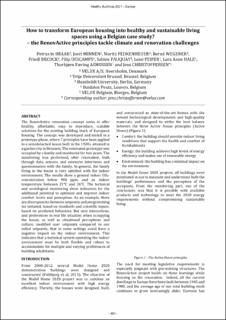How to transform European housing into healthy and sustainable living spaces using a Belgian case study? – the RenovActive principles tackle climate and renovation challenges
Braak, Petrus te; Minnen, Joeri; Fedkenheuer, Moritz; Wegener, Bernd; Decock, Friedl; Descamps, Filip; Pauquay, Sabine; Feifer, Lone; Hale, Lara Anne; Asmussen, Thorbjørn Færing; Christoffersen, Jens
Chapter, Peer reviewed, Conference object
Published version
Permanent lenke
https://hdl.handle.net/11250/2976107Utgivelsesdato
2021Metadata
Vis full innførselSamlinger
- SINTEF Proceedings [402]
Sammendrag
The RenovActive renovation concept seeks to offer healthy, affordable, easy to reproduce, scalable solutions for the existing building stock of European housing. The concept was developed and tested in a prototype phase, where 7 principles have been applied to a semidetached house built in the 1920s, situated in a garden city in Brussels. The renovated prototype was occupied by a family and monitored for two years. The monitoring was performed, after renovation, both through data, sensors, and extensive interviews and questionnaires with the family. In general, the family living in the house is very satisfied with the indoor environment. The results show a general indoor CO2- concentration below 900 ppm, and an indoor temperature between 21°C and 26°C. The technical and sociological monitoring show indication for the additional potential to optimize and improve indoor comfort levels and perception. As an example, there are discrepancies between setpoints and programming we initiated, based on standards and scientific inputs, based on predicted behaviors. But user interactions, and preferences in real life situation when occupying the house, as well as situational perceptions and culture, modified user setpoints compared to our initial setpoints, that in some settings could have a negative impact on the indoor environment. This indicates that a technical system operating the indoor environment must be both flexible and robust to accommodate for multiple and varying preferences of building inhabitants.

